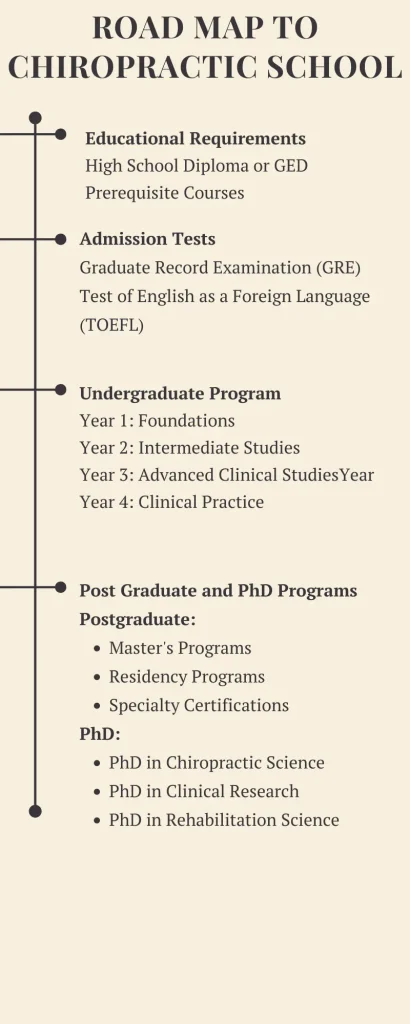How Long is Chiropractic School
How long is chiropractic school? Typically, it takes about 7-8 years to become a chiropractor. This includes 3-4 years of undergraduate studies followed by 3-4 years in a chiropractic program. The duration may vary based on the institution and specific program requirements.
What is Chiropractic School?
Chiropractic school is a specialized educational institution that trains students to become chiropractors. It involves an intensive curriculum that combines classroom instruction, laboratory work, and clinical experience. Students study subjects such as anatomy, physiology, biochemistry, and chiropractic techniques. The goal is to equip them with the knowledge and skills necessary to diagnose and treat musculoskeletal disorders, particularly those affecting the spine.

In addition to the rigorous coursework, chiropractic school also emphasizes hands-on training. Students spend significant time in clinical settings where they learn to apply chiropractic adjustments and other therapeutic procedures. They also gain experience in patient management and communication, ensuring they can provide comprehensive care. Graduates of chiropractic school are prepared to pass national and state licensing exams, allowing them to practice as licensed chiropractors.
How Long is Chiropractic School
The journey to becoming a chiropractor begins with a minimum of three years of undergraduate study. Upon completing the undergraduate program, individuals can enroll in a Doctor of Chiropractic degree program,
Year 1: Foundations
Semester 1:
Anatomy I: Introduction to human anatomy, focusing on the musculoskeletal system.
Physiology I: Basic principles of physiology, including cellular functions and major body systems.
Biochemistry: Introduction to the chemical processes within living organisms.
Chiropractic Principles I: Overview of chiropractic history, philosophy, and basic concepts.
General Biology: Fundamental concepts in biology with a focus on human biology.
Semester 2:
Anatomy II: Continuation of human anatomy with emphasis on the nervous system and internal organs.
Physiology II: Further exploration of physiological processes, including the endocrine and reproductive systems.
Histology: Study of tissues and cells through microscopic examination.
Chiropractic Techniques I: Introduction to basic chiropractic adjustment techniques.
Pathophysiology I: Introduction to disease processes and how they affect the body.
Year 2: Intermediate Studies
Semester 3:
Neuroscience I: Basic principles of neuroanatomy and neurophysiology.
Microbiology: Study of microorganisms and their effects on human health.
Chiropractic Principles II: Advanced concepts in chiropractic philosophy and ethics.
Radiology I: Introduction to diagnostic imaging, including X-ray techniques and safety.
Pathophysiology II: Continuation of disease processes, focusing on more complex conditions.
Semester 4:
Neuroscience II: Advanced topics in neuroanatomy and neurophysiology.
Radiology II: Advanced diagnostic imaging techniques and interpretation.
Chiropractic Techniques II: Intermediate chiropractic adjustment techniques.
Nutrition: Principles of human nutrition and its role in health and disease.
Public Health: Introduction to public health principles and epidemiology.
Year 3: Advanced Clinical Studies
Semester 5:
Orthopedics: Study of musculoskeletal disorders and their chiropractic management.
Chiropractic Techniques III: Advanced chiropractic adjustment techniques.
Clinical Diagnosis I: Methods for assessing and diagnosing patient conditions.
Rehabilitation: Techniques for physical rehabilitation and therapeutic exercises.
Research Methods: Introduction to research methodologies and critical analysis of scientific literature.
Semester 6:
Clinical Diagnosis II: Advanced diagnostic techniques and case studies.
Pediatrics: Chiropractic care specific to infants and children.
Geriatrics: Chiropractic care for the elderly population.
Sports Chiropractic: Specialized care for athletes and sports-related injuries.
Practice Management I: Basics of running a chiropractic practice, including business and legal aspects.
Year 4: Clinical Practice
Semester 7:
Clinical Internship I: Hands-on experience in a chiropractic clinic under supervision.
Advanced Techniques: Mastery of various chiropractic techniques and patient management.
Neuromusculoskeletal Diagnosis: In-depth study of diagnosing neuromusculoskeletal conditions.
Practice Management II: Advanced topics in practice management and marketing.
Ethics and Jurisprudence: Legal and ethical issues in chiropractic practice.
Semester 8:
Clinical Internship II: Continued hands-on clinical experience, with increased responsibility.
Integrative Healthcare: Collaboration with other healthcare professionals and holistic approaches.
Case Management: Comprehensive case studies and patient management strategies.
Special Topics in Chiropractic: Elective courses on specialized areas of interest.
Board Exam Preparation: Focused preparation for chiropractic licensing examinations.

How to Enter Chiropractic School
Educational Requirements
Prerequisite Courses:
Biology: 1 year with lab
Chemistry: 1 year with lab (General and Organic Chemistry)
Physics: 1 year with lab
Anatomy & Physiology: 1 semester each
Social Sciences/Humanities: Courses such as psychology, sociology, or English
Electives: Additional coursework in related areas is often recommended
Entry Tests
Graduate Record Examination (GRE): Some chiropractic schools require GRE scores, but this is less common than for other professional programs.
Test of English as a Foreign Language (TOEFL): Required for international students whose primary language is not English.
Application Process
- Research Schools:
Identify accredited chiropractic schools and review their specific admission requirements.
2. Application Submission:
Application Form: Complete the application form through the school’s website or a centralized application service like ChiroCAS.
Application Fee: Pay the required application fee.
3. Submit Transcripts:
Provide official transcripts from all post-secondary institutions attended.
4. Letters of Recommendation:
Submit 2-3 letters of recommendation, typically from academic professors, chiropractors, or other healthcare professionals.
5. Personal Statement:
Write a personal statement or essay explaining your interest in chiropractic, career goals, and why you chose the specific school.
6. Interview:
Attend an interview if required by the school. This could be in-person or virtual.
Financial Aid
Scholarships:
Merit-based Scholarships: Offered based on academic performance.
Need-based Scholarships: Provided based on financial need.
School-specific Scholarships: Available through individual chiropractic schools.
Grants:
Federal Grants: Such as the Pell Grant, for eligible students.
State Grants: Vary by state and can be need-based or merit-based.
Loans:
Federal Student Loans: Includes Direct Subsidized Loans, Direct Unsubsidized Loans, and PLUS Loans.
Private Loans: Available through banks and other financial institutions.
Work-Study Programs:
Part-time employment opportunities provided through the school to help students earn money for educational expenses.
Payment Plans:
Many schools offer flexible payment plans to help manage tuition payments.
Veterans Benefits:
GI Bill: Benefits for military veterans and their families.
Yellow Ribbon Program: Additional support for veterans.
Post Graduate and PhD Programs
Postgraduate Programs in Chiropractic School
Master’s Programs:
Master of Science in Clinical Chiropractic: Advanced clinical training focusing on diagnosis, patient management, and treatment techniques.
Master of Science in Sports Science and Rehabilitation: Specialized training in chiropractic care for athletes, sports injuries, and rehabilitation techniques.
Master of Science in Diagnostic Imaging: Training in advanced diagnostic imaging techniques, including MRI, CT, and ultrasound.
Residency Programs:
Clinical Residency: Advanced clinical practice under supervision in a healthcare setting.
Sports Chiropractic Residency: Specialized residency focusing on sports-related injuries and athlete care.
Diagnostic Imaging Residency: In-depth training in diagnostic imaging interpretation and techniques.
Specialty Certifications:
Chiropractic Pediatrics: Certification in pediatric chiropractic care.
Chiropractic Orthopedics: Advanced training in musculoskeletal disorders and orthopedic conditions.
Chiropractic Neurology: Specialization in neurological conditions and their chiropractic management.
Rehabilitation Certification: Focus on physical rehabilitation and therapeutic exercises.
PhD Programs in Chiropractic School
PhD in Chiropractic Science:
Program Focus: Advanced research in chiropractic theory, practice, and outcomes. Emphasis on developing new chiropractic techniques and contributing to scientific knowledge in the field.
Coursework: Research methodology, advanced chiropractic principles, healthcare policy, and biostatistics.
Dissertation: Original research project contributing new knowledge to the field of chiropractic.
PhD in Clinical Research:
Program Focus: Training in clinical research methods, including clinical trials, epidemiology, and biostatistics. Emphasis on evidence-based practice and improving patient outcomes.
Coursework: Clinical research design, advanced statistics, healthcare ethics, and evidence-based practice.
Dissertation: Research project focusing on clinical outcomes, treatment efficacy, or health services research in chiropractic care.
PhD in Rehabilitation Science:
Program Focus: Advanced study of rehabilitation techniques, including physical therapy, occupational therapy, and chiropractic care.
Coursework: Rehabilitation methodologies, advanced biomechanics, neurorehabilitation, and health services research.
Dissertation: Original research contributing to the understanding and improvement of rehabilitation practices.
Top 10 Chiropractic Schools

Here are the top 10 chiropractic schools in the world offering comprehensive programs:
1.Life University
Doctor of Chiropractic Degree Program
Specializations in Sports Emphasis and Functional Nutrition
2.Northwestern Health Sciences University
Doctor of Chiropractic Degree Program
Graduate Certificate in Functional Sports and Performance Nutrition
Bachelor of Science in Human Biology Degree Completion Program
3.Palmer College of Chiropractic
Doctor of Chiropractic Degree Program
4.Logan University
Doctor of Chiropractic Degree Program
Postgraduate Programs in Specialized Areas
5.Cleveland University-Kansas City
Doctor of Chiropractic Degree Program
Postgraduate Programs in Specialized Areas
6.Parker University
Doctor of Chiropractic Degree Program
Postgraduate Programs in Specialized Areas
7.University of Western States
Doctor of Chiropractic Degree Program
Postgraduate Programs in Specialized Areas
8.Southern California University of Health Sciences
Doctor of Chiropractic Degree Program
Postgraduate Programs in Specialized Areas
9.New York Chiropractic College
Doctor of Chiropractic Degree Program
Postgraduate Programs in Specialized Areas
10.National University of Health Sciences
Doctor of Chiropractic Degree Program
Postgraduate Programs in Specialized Areas
Factors Affecting the Length of Chiropractic School
Several factors can influence the duration of chiropractic school:
Curriculum Intensity: Rigorous coursework and faster pace can lead to a shorter completion time, preparing students for the professional environment sooner.
Program Structure: Some programs may extend their curriculum over a longer period, while others cover more in a shorter duration.
Clinical Opportunities: Programs with robust community-based internship programs empower students to have a wider range of experiences, potentially affecting the duration of the program.
Postgraduate Specializations: Pursuing postgraduate programs in specialized areas can add to the overall length of education.
Accreditation Requirements: Accredited Doctor of Chiropractic degree programs must provide a minimum of 4,200 instructional hours, which can impact the program length.
Final Verdict
In conclusion, the duration of chiropractic school varies depending on the specific program and individual circumstances. The completion time can range from three and a half years to five years, with several factors influencing the overall length of education. Aspiring chiropractors should carefully consider these factors and choose a program that aligns with their career goals and aspirations, ensuring they are well-prepared for a successful chiropractic career.
FAQs
1. How long does it take to become a chiropractor?
Typically, completing a Doctor of Chiropractic (D.C.) program takes about 4 years, in addition to at least 3 years of undergraduate study.
2. Are there specialized areas of focus in chiropractic education?
Yes, many chiropractic schools offer specialized areas of focus such as sports emphasis, functional nutrition, and postgraduate programs in specialized areas.
3. What are the prerequisites for enrolling in a chiropractic program?
Prerequisites may vary, but common requirements include at least 3 years of undergraduate education, coursework in sciences, and completion of specific undergraduate majors such as biology or related fields.
4. How can I expedite my chiropractic education?
Opting for programs with faster completion times, such as those with rigorous coursework and shorter breaks, can help in expediting chiropractic education.
5. Can I pursue postgraduate programs in chiropractic?
Yes, many chiropractors complete postgraduate programs that lead to diplomate credentials, providing additional training in specialty areas such as orthopedics, acupuncture, and pediatrics
